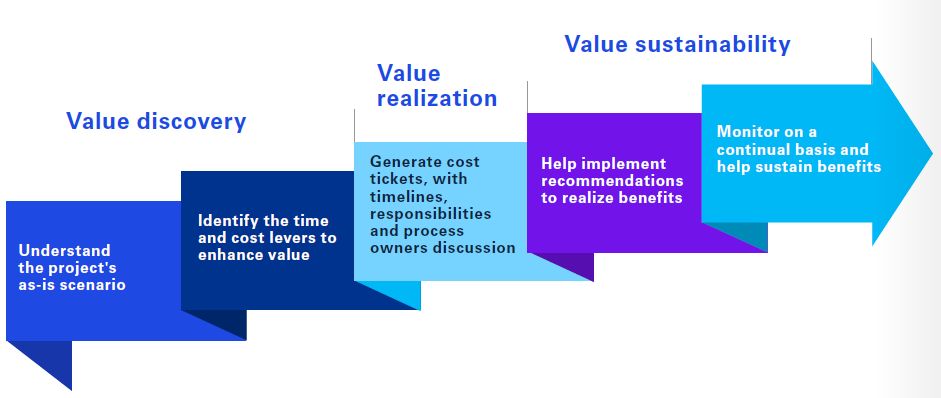The main pillars of successful projects management
Successful projects are delivered through effective leadership and management approaches across all stages of their life cycle – from inception to post decommissioning. There is a wide range of opportunities to enhance a project’s net present value (NPV), creating positive impact for all stakeholders.
The main pillars of successful projects management approach include:
- Early planning and design readiness
- Effective partnering with key project parties through correct contractual modality
- Implementing integrated project control systems and methodology
- Continuous improvement through value engineering and management
Risk factors contributing to project delays and budget overruns
The predictability of completing projects on time within allocated budgets is still relatively low. Risk factors and uncertainties contributing to project delays and budget overruns arise from different stakeholders:
Sponsor-related risk factors
- Unaligned interface and dependency management across multiple project packages
- Insufficient designs leading to higher provisional sums in contracts
- Inadequacies in implementing a gateway approach across development phases
- Elapsed project appraisal and design management timeline leaving compressed/unrealistic construction delivery periods
- Limited internal project control teams leading to higher reliance on associated project parties
- Limited real-time visibility of the project performance indicators
- Ineffective partnership with the construction firm, unfavorable contracting terms and faltering of payments across the construction value chain leading to deteriorating cashflows
Contractor/sub-contractor risk factors
- Over commitment and understaffing by construction firms across multiple projects
- Unfavorable contract and squeezing payment terms and margins with suppliers and small/medium sub-contractors resulting in insolvency of smaller contracting firms
- Diverting resources within multiple projects to rebalance the cashflow and progress
- Frequent organizational restructuring resulting in limited executive commitment to existing projects
- Inadequate planning, scheduling and resource management at crew level based on the bottom-up approach
- Inadequate allocation of equipment, manpower and construction sequencing leading to lower productivity
Consultant-driven risk factors
- Co-sharing of resources and consultants’ commitment to multiple projects
- Non-adherence to the design and budget across various phases, from project concept to construction
- Delayed approvals of contractor/client deliverables
- Frequent revisions and changes in the design and specifications
- Limited contractual liability over the completion of the project on time within allocated costs
- Inadequate implementation of the engineering proposals
- Limited usage of the integrated project management information system for capturing real-time data
- Limited usage of advanced data analytics for predicting the certainty of the baselines
- Inadequate transitions from traditional to augmented reporting mechanisms including drones, digital labor, augmented reality, BIM, smart glasses and voice enabled devices for multi-directional audiovisual communications
- Inadequate adoption of design and technology to achieve net-zero carbon emission buildings
Capital projects audit helps in implementing course corrections and preventing leakages across the value chain
Auditing across the development cycle of a complex project comes with significant risks and opportunities. Therefore, an experienced consulting and assurance partner is essential throughout all phases of the project development cycle for organizations with limited technology, reporting methodologies and expertise.
Implementing a rigorous capital projects audit plan can also significantly increase transparency for project sponsors and contractors and supports timely action for mega projects. Capital projects audit professionals utilize core audit and project management process analysis skills to help project parties identify exceptions and risk, as well as create value, improve operational efficiencies and identify cost saving opportunities across various project functions.
Cost improvement opportunities identified through capital projects audit
Contact us
Connect with us
- Find office locations kpmg.findOfficeLocations
- kpmg.emailUs
- Social media @ KPMG kpmg.socialMedia
Stay up to date with what matters to you
Gain access to personalized content based on your interests by signing up today





